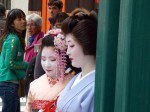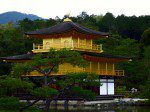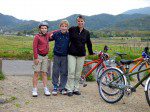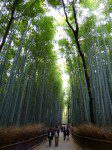Six hundred years of raking gravel
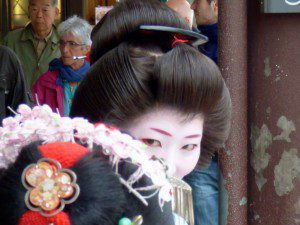
Into every life some mundanity must fall. We spent this morning doing our washing, catching up on emails, and drinking coffee – which was remarkably relaxing. Then, before lunch, we set out through the geishas of Gion to go to the other side of Kyoto on the bus.
Like every other piece of public transport we’ve dealt with in Japan, the Kyoto bus system is a joy. That said it’s also a bit strange. The buses don’t just stop at stops, they actually stop: The driver turns off the engine. Given that sometimes a stop involves no more than a few seconds it actually becomes extremely irritating after a little while, although I imagine it saves some fumes and petrol.
Anyway, this afternoon wasn’t about buses it was bikes. Kyoto is nice and flat, the drivers are completely non-aggressive, and no one minds you riding on the footpath – it’s a cycling heaven. We went on a cycling tour of some of Kyoto’s major sights. We saw the Golden Pavilion which is literally covered in gold. It has been since it was built; but it was refurbished in 1987 at the height of the Japanese economic boom and major companies vied to donate so the current gold leaf is twice as thick as the original. The surrounding gardens really leave the Pavilion in the dust in my view.
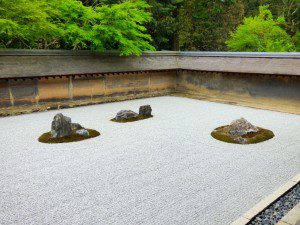
Then it was the Ryoanji Temple which is a lovely building although it was entirely reconstructed about 150 years ago after a major fire. The thing that survived the fire and that has been the same for over 600 years is the rock garden. No trees in this garden, just 15 rocks and a swimming pool of gravel which has been being raked for over half a millennia. Can’t say it looked like much to me, but I love the concept. Really, it doesn’t look all that great in itself; but contemplate the level of effort involved to achieve the harsh, dry simplicity and you can only wonder at the result.
On again and out into the countryside, past a lake full of fish surrounded by original wooden houses. Past rice fields with dykes made of stones. To a bamboo forest, a huge towering bamboo forest. This is a place where bamboo gets to be truly big and impressive. By now, though, our sense of being impressed was thoroughly overcome by our sense of being cold and wet, so we were relieved to head to the train station and make our way homewards.
Back in the Gion district we had dinner in a local restaurant. Continuing a theme of our round the World trip we had okonomiyaki – Japanese pancakes. The little restaurant was blessedly warm, and we warmed up even more when they started up the hotplate that made up most of our table. Okonomiyaki (which translates literally as ‘fried stuff you like’) turned out to be closer to potato pancakes than crepes, really basic compared to our feasts of nights past; they also proved to be wonderfully tasty. Sometimes the simple things are just what’s needed.
